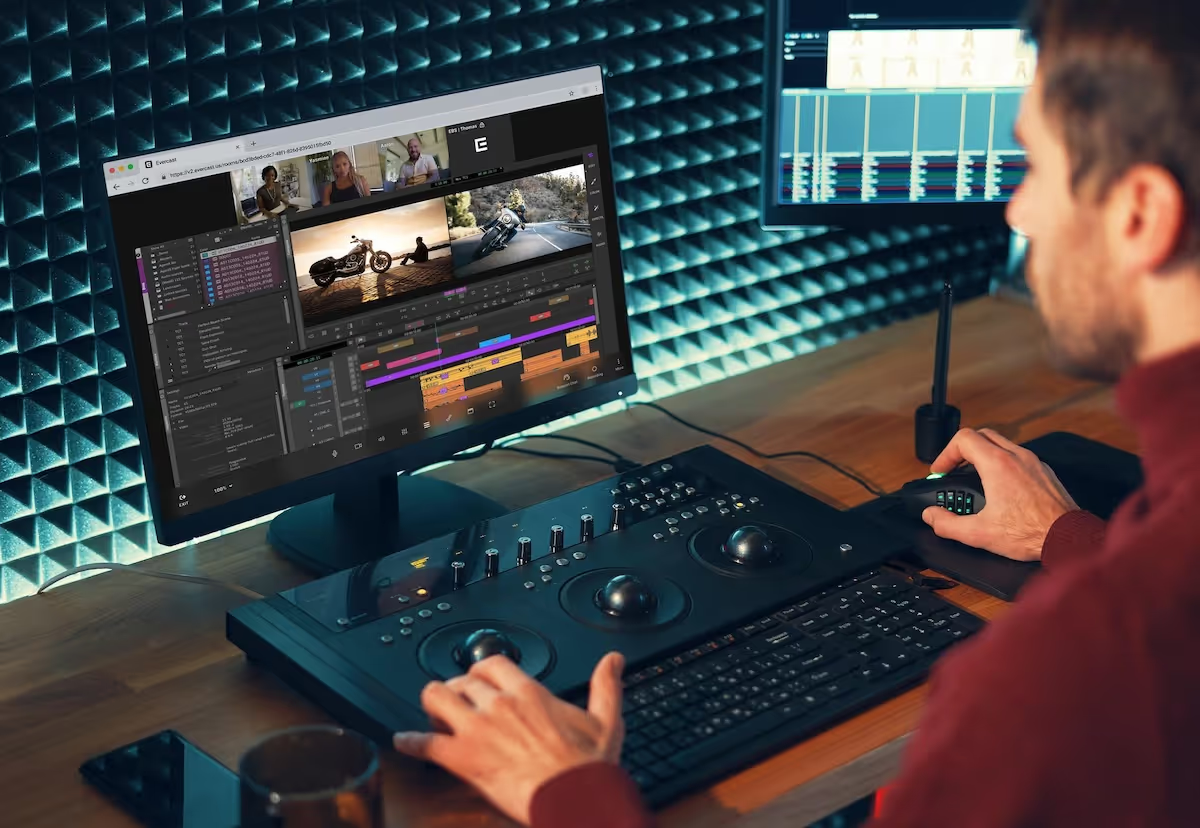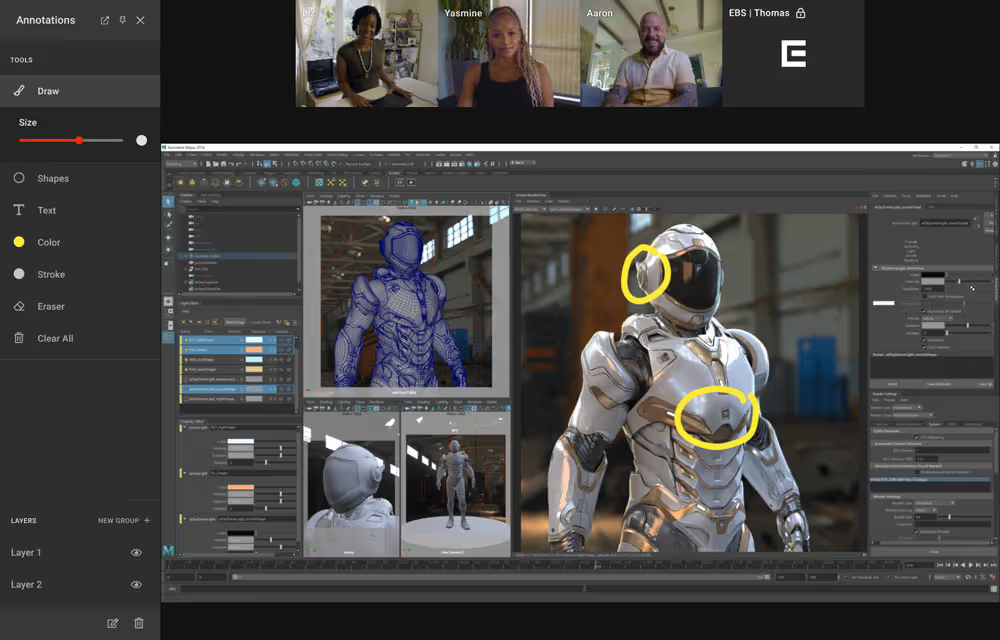You did the work. You spent hours upon hours honing edits. You tweaked every mask, perfected your visual effects, and tried to refrain from wondering how many weeks of your life you gave to keyframing in this project alone.
Now, all you have to do is present it, get feedback, and make the final live edits in Adobe After Effects to get it to the finish line.
Except during the Zoom session… the stream stutters. Skips crucial moments. Freezes in place. You scrub backward, apologizing and trying to figure out where to resume playback as you try not to let your session—and confidence—collapse like a fading vignette. But to no avail.
At best, you’re collaborating with your team. They understand these annoying hiccups are inherent to CPU/GPU-heavy streaming. And yet, you still can’t get your work done.
At worst, your client wonders if these technical issues are representative of your work as a whole—whether or not they can actually see it. If you can’t even present it, what faith should they have that what you deliver can meet expectations?
It’s an unfortunate and all-too-common reality. Thankfully, there are other solutions. Here are the most popular workarounds to live stream After Effects without lag, helping ensure a smooth editing session with your remote clients and collaborators.
Why streaming Adobe After Effects usually causes lag
While video conferencing options like Zoom work perfectly well for discussions or basic presentations, most simply aren’t equipped to handle the rigors of streaming professional-grade media workspaces.
Put simply, sharing your screen is already a computationally heavy undertaking. The video resolution of the stream itself depends entirely on your screen’s resolution, graphics card, operating system capabilities, and CPU usage—and that doesn’t even account for the quality and speed of your internet connection.
Now, compound that with other significant factors, including:
- The substantial CPU/GPU required to run—and stream—Adobe After Effects
- The resolution compression Zoom introduces to minimize bandwidth to ensure smooth and stable streaming
- The capabilities of other meeting members’ computers and connections
Given all of the above, it’s easy to see why lag commonly occurs. So, how can you get around it?
5 ways to live stream After Effects without lag
Evercast
As in life, the best solutions are often the simplest. While you can juggle multiple tools or use complex workarounds to live stream, you only invite more potential points of failure into your operations—which is exactly why Evercast is one of the best tools available.

Designed for production professionals who work in an industry where quality and accuracy are paramount, Evercast is an all-in-one solution for streaming workflows in real time. With built-in video conferencing, Evercast offers a 4K, 60fps frame-accurate feed with plenty of helpful tools like annotations and recording to make collaboration before and after the session a breeze. Just ask the professionals themselves:
“Evercast gives every project I am on the platform for all my clients to be a part of the process, even if it's for an hour at a time. . .It is a must have for anyone in post-production.”
— Jason Uson, senior lead editor, Dell Blue Creative (Dell Technologies)

Pros
- Stream from any source—live cameras, media files, or any creative software—even multiple sources at a time, with up to 4K resolution at 60fps, in-sync audio/video, and no lag (150ms average global latency)
- Collaborative features, including 4K screen share, chat, draw/text tools, and recording with interactive playback
- Stream with industry-leading quality, including full-spectrum audio and multi-channel surround sound, as well as color precision up to 10-bit 4:4:4 color (when streaming from Blackmagic DeckLink or local files)
- Seamless integration with access through Google Chrome or via dedicated apps for macOS, Windows, iPhone, iPad, and Apple TV
- Security approval from all major Hollywood studios worldwide, plus top game developers and ad agencies, with features like encrypted streaming, single-sign-on, watermarking, and more.
- 24/7 white-glove tech support.
Cons
- Higher price point than consumer-grade tools (though flexible pricing options are available on a project-to-project basis)
- Generally intended for professional projects, Evercast is less suitable for those working exclusively on casual projects.
To see all the benefits this platform offers, you can learn more about Evercast here, or book a personalized demo for your next editing session.
Create together remotely, in real time

OBS + NDI
Another helpful live streaming option is using an NDI (Network Device Interface) with an OBS (Open Broadcaster Software) to divide and optimize your resources independently before combining them to produce the seamless video stream you’re after.
To contextualize this, imagine having two devices: one dedicated to editing in Adobe After Effects and the other to video conferencing with clients or collaborators. By sending the editing feed to the conferencing source, you can produce a high-quality video stream without compromising either device’s performance.
Pros
- Enhanced control of your session’s audio and video outputs beyond other Zoom-like platforms, providing higher-quality streaming options
- Integrates directly into Zoom, allowing you to collaborate with clients and team members on a platform they’re likely more familiar with
Cons
- Takes some getting used to, requiring downloaded plugins, configuration tools, platform-specific screencast software, and adjusting settings
- Performance limitations on virtual camera setups for high-level project use
- Introduces additional points of failure via the use and configuration of plugins, tools, and software
- Depends on a local network for filtering through OBS and external conferencing tools, creating unnecessary latency due to the latter not being optimized for CPU-heavy workflows
For a more comprehensive breakdown of this method, check out our article on using NDI for streaming.
Zoom + NDI
By utilizing the resource allocation benefits of an NDI and combining it with Zoom Rooms, this option offers a higher-quality video stream than Zoom alone, allowing you to more effectively edit, collaborate, and conference with team members or clients.
Pros
- High-quality video at low latency (up to 1080p)
- Better control over streaming options than Zoom screen sharing alone
Cons
- Requires meeting Zoom-based prerequisites, including an up-to-date Zoom Rooms license, a Zoom Rooms controller, compatible cameras, an NDI itself, and other tools that support NDI
- Requires setup and maintenance, including changing NDI and support tool settings, as well as in the Zoom Web Portal
- Forces editors to choose between streaming the NDI or their face, compromising effective communication
- 1080p limits most video professionals
- Limited controls with Zoom over audio quality, making some projects untenable
For a comprehensive explanation of this approach, check out our article on how to use Zoom Rooms + NDI for streaming.
Zoom + OBS
OBS is free, open-source software for live streaming and recording, making it one of the cheapest options available. It’s also compatible with Windows, Mac, and Linux and still offers an upgrade in performance and quality over a standard Zoom meeting.
Unfortunately, it lacks many benefits other solutions have and comes with similar drawbacks.
Pros
- Improved quality over a standard Zoom meeting
- One of the most affordable options
- Compatible with Windows, Mac, and Linux
Cons
- Requires a modest setup, configuration, and consistent updates in OBS and Zoom
- Outdated OBS user interface that takes time to learn
- Demands considerable CPU power for OBS and is prone to lag, which can become problematic in a live collaborative setting
- Laborious process for providing and collecting feedback, with no built-in annotation tools and requiring stopping/starting playback for verbal notes
- Points of failure still exist between users, OBS, and Zoom.
For a more comprehensive understanding of this method, check out our article on how to use OBS with Zoom for streaming.
Remote Desktop
Remote desktop solutions include a number of different service providers like Splashtop or Jump Desktop. However, believe us when we say you can take your pick, and the results remain the same.
Although sharing your desktop remotely can arguably be more suitable for real-time graphic-intensive work, the disadvantages of using them for streaming video in a conference setting tend to outweigh that sole benefit.
Pros
- Can be more effective for real-time CPU/graphics-heavy work than some other options
- Often comes with comprehensive security
Cons
- Requires other tools for conferencing and collaboration
- Typically only appropriate for one-on-one single active-user scenarios
- Hard sell to request remote access if working with a client, as their computers may contain other sensitive material
As you can see, numerous functional solutions are available for collaborating on high-quality media production projects. However, only one option truly offers a comprehensive solution without the significant limitations of the others, and that’s Evercast.
To learn more about Evercast, click here.














